Teledyne Ryan Q-2/KDA/xQM-34/BGM-34 Firebee
The Firebee series of targets drones and RPVs (Remotely Piloted Vehicles) is one of the most successful and versatile unmanned aircraft developed so far. The latest versions are still in wide-spread service more than 50 years after the first flight tests.
Because of the wide variety of variants covered by the xxM-34 series of designations, this article is split into four parts, each describing chronologically the development of a specific sub-family of Firebee vehicles:
- Subsonic Targets: BQM-34A, AQM-34B/C, MQM-34D, BQM-34S
- Supersonic Targets: BQM-34E/F/T
- Reconnaissance RPVs: AQM-34G/H/J/K/L/M/N/P/Q/R/U/V
- Attack and Multimission RPVs: BGM-34A/B/C
The image below shows almost all variants of the xxM-34 family, which are mentioned in this article:
 |
| Image: Teledyne Ryan |
| Family of Teledyne Ryan targets and RPVs |
Subsonic Targets: BQM-34A, AQM-34B/C, MQM-34D, BQM-34S Firebee I
In 1948, the Pilotless Aircraft Branch of the USAF issued a requirement for a jet-powered aerial target with a high subsonic speed, for use in ground-to-air and air-to-air gunnery. The designation Q-2 was assigned to the project, and in August 1948, Ryan was announced winner of the design competition. The first powered flight of an XQ-2 occurred in early 1951, and in the same year, the drone was ordered into mass production as the Q-2A Firebee. Similar versions were also ordered by the U.S. Navy and U.S. Army as KDA-1 and XM21, respectively.
The Q-2A Firebee was a target drone powered by a Continental J69-T-19 turbojet. When ground lauched, the drone was boosted into the air by an Aerojet General X102F solid-fueled rocket booster. The Navy's KDA-1 and Army's XM21 were powered by a Fairchild J44-R-20 engine, and could be recognized by the distinctive intake center body. The Firebee could be recovered by a two-stage (brake/descent) parachute system, which was automatically deployed when the drone was hit, or when vital components like engine or remote control equipment failed. Of course the parachute descent could also be initiated manually by radio command.
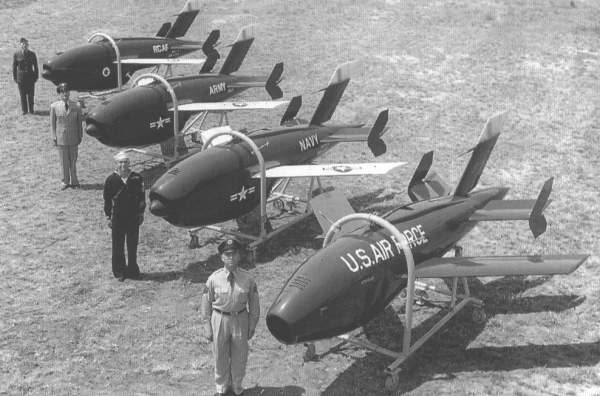 |
| Photo: Ryan Aeronautical |
| From front: Q-2A, KDA-1 (AQM-34B), XM21, KDA-4 (AQM-34C) |
The XQ-2B was a high-altitude/long-range development of the Q-2A with an uprated engine. It was not built in quantity, but in 1957 an XQ-2B attained an altitude record for unmanned aircraft of 16200 m (53000 ft).
The Q-2C (Ryan Model 124) was an improved version with a significantly higher performance. The first XQ-2C prototype flew in December 1958, and the Q-2C went into production in 1960. It had a larger and heavier airframe with a new nose configuration ("chin" intake) and longer wings, and also an uprated J69-T-29 engine. The Q-2C soon replaced most of the earlier drones, and became the standard subsonic Firebee target configuration, which remains essentially unchanged to this day. To distinguish them from the supersonic Firebee II variants (q.v.), the subsonic targets are nowadays usually referred to as Firebee I.
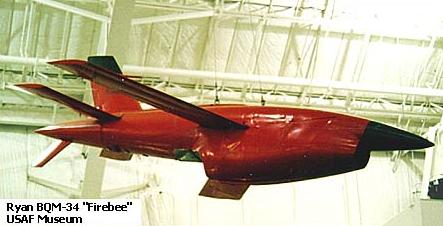 |
| Photo: U.S. Air Force Museum |
| XQ-2C (BQM-34A) |
The Q-2D was a projected very high altitude (25000+ m (80000+ ft)) development of the Firebee, which was not built.
Improved Navy variants included the XKDA-2, which was a KDA-1 modified with a flotation gear and a J44-R-20A engine, and the XKDA-3, which used the J44-R-26 engine for higher altitude and endurance. Neither the XKDA-2 nor the XKDA-3 were produced in quantity. The Navy's main production model of the early Firebee series was the KDA-4, which was similar to the KDA-1, except for an uprated J44-R-20B engine and a new autopilot.
In June 1963, the existing Firebee targets were redesignated in the xQM-34 series as follows:
| Old Designation | New Designation |
|---|---|
| Q-2C | BQM-34A |
| KDA-1 | AQM-34B |
| KDA-4 | AQM-34C |
By that time, the Army had already phased out the early XM21 version, and had adopted the Ryan Model 124E, a ground launched version of the BQM-34A with slightly longer wings and a longer-buring booster. This variant was subsequently designated MQM-34D. The U.S. Navy also soon discarded its last AQM-34B/C targets (which had received AQM designations, because they were almost exclusively air-launched) and adopted the BQM-34A, too. The BQM-34A was produced until 1982, when the production line closed because no new orders were forthcoming.
In the early 1970s, the U.S. Army needed a high-performance target in the 960 km/h (600 mph) class for realistic evaluation of the FIM-92 Stinger man-portable surface-to-air missile, and sought for ways to improve the performance of the MQM-34D without too extensive alterations. The obvious way was to install a higher-rated engine, and the General Electric J85 was selected for the purpose because it had similar dimensions as the J69. To accomodate the new engine, the nose of the Firebee had to be redesigned with a large nose intake instead of the usual "chin" intake. Initial flight tests of the new drone, known as Ryan Model 251, with the J85-GE-4 were only partially successful, but the use of J85-GE-7 engines (taken from retired ADM-20C Quail missiles) finally resulted in the desired high-performance configuration of the Firebee I. Despite the changes to the drone, no new MQM-34 suffix letter was allocated to the Model 251, and it was known to the Army as MQM-34D Mod II.
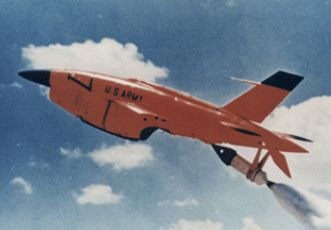 |
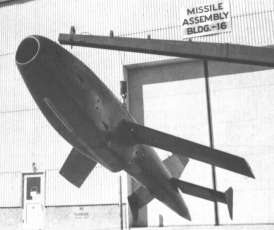 | |
| Photos: U.S. Army | ||
| MQM-34D | MQM-34D Mod II | |
The U.S. Navy was also upgrading its Firebees during the 1970s. Around 1973/74, the Navy developed the AN/USW-3(V) ITCS (Integrated Tracking and Control System) as a common control system for different types of aerial targets. To work with ITCS, the Navy's BQM-34As were equipped with AN/DKW-1 (later AN/DKW-2 and -3B) guidance transponders, and redesignated BQM-34S. In 1983, the Navy tested the installation of the J85 engine, but eventually selected an upgraded J69, the J69-T-41A. In the mid-1980s, all Navy BQM-34A/S targets were upgraded to a common BQM-34S standard with ITCS and the -41A engine. In 1986, the Firebee I production line at Teledyne Ryan was reopened to produce more BQM-34S targets, as the Navy had expended the greater part of its original supply. Current BQM-34S have an upgraded A/A37G-8A flight control system.
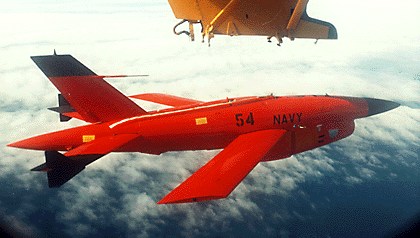 |
| Photo: U.S. Navy |
| BQM-34S |
The USAF began to improve its Firebee Is later than the other services, but finally also upgraded the engine to the J85-GE-7 model in the early 1980s. However, the installation was different from the Army's MQM-34D Mod II, and did not result in obvious changes to the nose profile. Current USAF Firebees are equipped with a Vega DTCS (Drone Tracking and Control System) and an updated 3-axis digital flight control system designated A/A37G-14. Despite the significant upgrades, the current USAF Firebee I targets are still designated as BQM-34A.
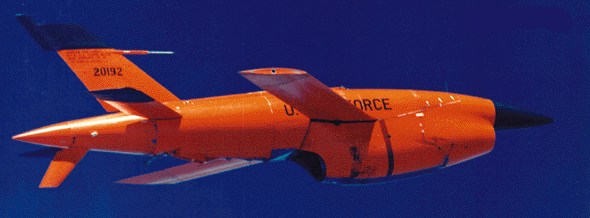 |
| Photo: USAF |
| BQM-34A |
Beginning in 1989, BQM-34A/S drones were equipped with the J85-GE-100 engine, increasing commonality between Air Force and Navy versions of the Firebee I. In 1999, some Firebees were fitted with a GPS receiver for more precise navigation. Current Firebee I targets can carry a wide variety of mission equipment. These include all sorts of ECM equipment (e.g. AN/DLQ-1/2/3, AN/DPT-1), chaff/flare dispensers (e.g. AN/ALE-33/40/44), transponders and tracking beacons (e.g. AN/DPN-88/90), scoring devices and miss-distance indicators (e.g. AN/DPQ-9, AN/DRQ-4, AN/DSQ-37/50), drop tanks for extended range, towed targets, and radar augmentors. One of the more important pieces of equipment are wingtip-mounted IR flares. In life firings of IR guided missiles, the latter will home on these flares, resulting in little damage to the drone itself which can then be reused.
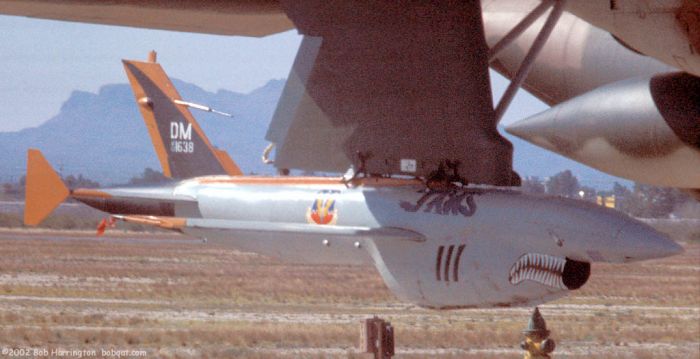 |
| Photo: Bob Harrington, Bobqat.com |
| BQM-34A |
The U.S. Air Force currently plans to replace expended BQM-34A targets by the new BQM-167 Skeeter, production of which began in 2004.
More than 6500 Firebee I targets of all versions have been built so far for the U.S. armed services, including about 1000 of the early Q-2A/KDA/XM21 variants. Current prime contractor for the Firebee is Northrop Grumman, after the acquisition of Teledyne Ryan Aeronautical in July 1999.
Specifications
Note: Data given by several sources show slight variations. Figures given below may therefore be inaccurate!
Data for Q-2A, BQM-34A/S, AQM-34C (BQM-34A/S performance data are for J85 engine):
| Q-2A | BQM-34A/S | AQM-34C | |
|---|---|---|---|
| Length | 5.27 m (17 ft 3.4 in) | 6.98 m (22 ft 10.8) | 5.36 m (17 ft 7.2 in) |
| Wingspan | 3.40 m (11 ft 2 in) | 3.93 m (12 ft 10.8 in) | 3.41 m (11 ft 2.4 in) |
| Height | 1.78 m (5 ft 10 in) | 2.04 m (6 ft 8.4 in) | 1.92 m (6 ft 3.6 in) |
| Weight | 840 kg (1850 lb) | 1130 kg (2500 lb) | 860 kg (1900 lb) |
| Speed | 840 km/h (520 mph) | Mach 0.96; 1110 km/h (690 mph) at 1980 m (6500 ft) | Mach 0.85 |
| Ceiling | 16000 m (52500 ft) | 18300+ m (60000+ ft) | 16000 m (52500 ft) |
| Endurance | 48 min. | 90 min. | 53 min. |
| Range | 640 km (400 miles) | 1300 km (800 miles) | 640 km (400 miles) |
| Propulsion | Booster (for ground launch only): MK 23 MOD 3 solid-fueled rocket; 51.6 kN (11600 lb) for 2.2 s | ||
| Continental J69-T-19B turbojet; 4.7 kN (1060 lb) |
BQM-34A (early): Continental J69-T-29 turbojet; 7.6 kN (1700 lb) BQM-34S (early): Continental J69-T-41A turbojet; 8.5 kN (1920 lb) BQM-34A/S (latest): General Electric J85-GE-100 turbojet; 10.9 kN (2450 lb) |
Fairchild J44-R-20B turbojet; 4.4 kN (1000 lb) | |
Supersonic Targets: BQM-34E/F/T Firebee II
In 1965, the U.S. Navy awarded Teledyne Ryan a contract to develop the Model 166 Firebee II, a supersonic derivative of the Model 124/BQM-34A Firebee I target. Although the Firebee II had a completely new, and much more slender, fuselage, it retained most of the systems of the Firebee I, including the basic J69 engine. To fit into the new fuselage, the J69-T-29 of the BQM-34A was redesigned into the YJ69-T-6 (later redesignated as J69-T-406). For recovery, the Firebee II used a two-stage parachute retrieval system similar to the Firebee I.
Because of the internal similarity (and to avoid the impression that a completely new drone was developed!), the Firebee II was also designated in the BQM-34 series. The first XBQM-34E flew in January 1968, and in 1969, the first orders for the BQM-34E production version were placed. In 1972, the BQM-34E became fully operational with the U.S. Navy.
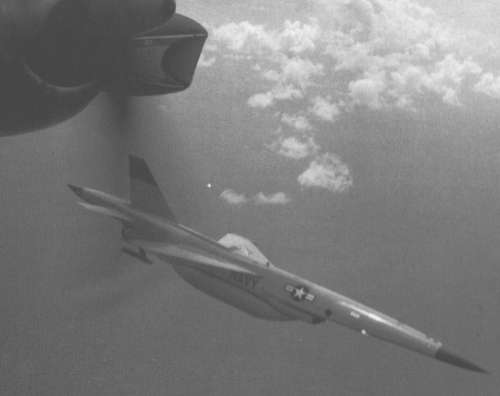 |
| Photo: Dave Gossett |
| BQM-34E |
The USAF ordered the Firebee II in 1969 as the BQM-34F. It was slightly heavier than the Navy's BQM-34E, because of different onboard systems, and an additional parachute for optional mid-air retrieval. In the MARS (Mid-Air Retrieval System), a helicopter would snatch the target while it floated to the ground on its parachutes, and carry the Firebee II back to base. The first BQM-34F was delivered to the Air Force in 1971.
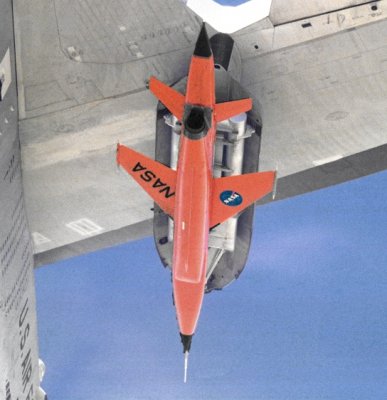 |
| Photo: NASA |
| BQM-34F |
When the U.S. Navy introduced the AN/USW-3(V) ITCS (see description of the BQM-34S above) in the early 1970s, the BQM-34E was upgraded with AN/DKW-1 ITCS guidance transponders. This resulted in the BQM-34T, which was otherwise identical to the BQM-34E.
The BQM-34E/F/T Firebee II could employ essentially the same payloads as the subsonic BQM-34A/S counterparts. To improve endurance, an external conformal fuel tank could be fitted. This limited the speed to high subsonic, and lead to a performance generally similar to that of the Firebee I. When production ended in 1980, almost 300 Firebee IIs of all versions had been built. In the early 1990s, the usual attrition of target drones had reduced the number of Firebee IIs to less than 50, and it is apparently no longer used nowadays.
Specifications
Note: Data given by several sources show slight variations. Figures given below may therefore be inaccurate!
Data for BQM-34E/F/T:
| BQM-34E/T | BQM-34F | |
|---|---|---|
| Length | 8.89 m (29 ft 1.9 in) | |
| Wingspan | 2.71 m (8 ft 10.8 in) | 2.94 m (9 ft 7.9 in) |
| Height | 1.71 m (5 ft 7.2 in) | |
| Weight | Air launch: 856 kg (1890 lb) Ground launch: 1030 kg (2280 lb) |
Air launch: 951 kg (2100 lb) Ground launch: 1110 kg (2450 lb) |
| Speed | Mach 1.1 at sea level) Mach 1.8 at 13700 m (45000 ft) |
Mach 1.1 at sea level) Mach 1.78 at 13700 m (45000 ft) |
| Ceiling | 18300 m (60000 ft) | 16800 m (55000 ft) |
| Endurance | 75 min. | |
| Range (with ext. tank) | Typical: 1125 km (700 miles) Maximum: 1430 km (890 miles) | |
| Propulsion | Booster (for ground launch only): solid-fueled rocket Teledyne CAE (Continental) J69-T-406 turbojet; 8.5 kN (1920 lb) | |
Reconnaissance RPVs: AQM-34G/H/J/K/L/M/N/P/Q/R/U/V
USAF interest to develop a reconnaissance RPV variant of the BQM-34A Firebee target emerged in 1961, when Ryan was instructed to convert a BQM-34A drone to reconnaissance RPV configuration under Project "Fire Fly". The result was the Model 147A, which first flew in April 1962. The 147A differed from the standard BQM-34A by a new navigation system and increased fuel, but was externally essentially identical. The 147A, like all early Model 147 variants, used the same J69-T-29 engine as the BQM-34A, and were likewise recovered by a two-stage parachute descent system. The Lockheed DC-130 Hercules was generally used as launch aircraft for the Model 147 drones.
The Model 147A tests were successful, and led to a long line of more extensive modifications, and most of the RPVs were used operationally over South-East Asia. Initially, no designations were assigned to Model 147 versions by the USAF. From 1969, however, the Air Force allocated AQM-34 designations with variuos suffix letters to the RPVs. Those models which were no longer in use at that time did never receive an AQM designation.
The Model 147B was the first high-altitude photo-reconnaissance RPV variant. It had a longer fuselage for additional fuel and payload, and its wingspan was more than doubled. It was used operationally between 1964 and 1965.
The 147C was a "short-wing" variant with only slightly larger wings than the 147A, and was used as a test and training model. The 147D was a modified 147C with an ELINT (Electronic Intelligence) payload of the CIA. The 147E combined the "big-wing" airframe of the 147B (with a slightly modified nose) with the ELINT payload of the 147D, and the 147F was a modified 147B used by the U.S. Navy as a testbed for the AN/ALQ-51 multi-band deception jammer and track breaker.
The 147G was a development of the 147B with a longer fuselage and a more powerful J69-T-41A engine. It had a zoom-lens equipped TV camera in the nose, together with a TV transmitter for real-time surveillance. Some 147Gs were later modified to 147J standard (q.v.), and one 147G was converted to XQM-103A configuration.
The Model 147H (later designated AQM-34N) was a special high-altitude reconnaissance version with an even larger wing than the 147B family. It had a span of 9.75 m (32 ft) and a wing area of 10.6 m² (114 sq ft) compared to 3.93 m/3.34 m² (12.9 ft/36 sq ft) of the 147A.
The 147J was a low-altitude photo-reconnaissance version of the 147G featuring a barometric altitude control system. With the 147J, a new recovery method was introduced. Helicopters equipped with MARS (Mid-Air Retrieval System) could "snatch" the drones floating down on their parachutes in mid-air and carry them back to the operating base. Retrieval was much quicker this way, and limited damage to the drone by impact in rugged terrain.
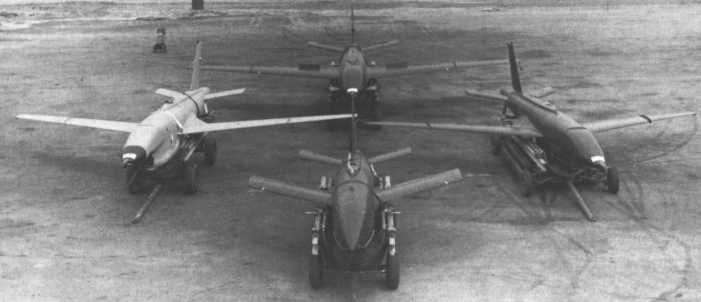 |
| Photo: via Jane's |
| Clockwise from front: 147NX, 147J, 147H (AQM-34N), 147G |
The 147N was a non-recoverable medium-altitude decoy based on the 147A, and was used to distract the air-defenses from the recce RPV following it. Some of the decoys made it back to friendly airspace, only to crash due to the lack of a recovery system. Therefore, the next decoys were built to Model 147NX configuration, which added the retrieval system and a simple photo-reconnaissance capability. The 147NQ was the low-altitude variant of the 147NX.
The AQM-34G was a medium-altitude ECM variant built under the USAF's "Compass Bin" program. It was externally similar to the 147C/D, and carried active jamming or passive AN/ALE-2 chaff-dispensing pods. The initial AQM-34Gs were Model 147NA, and later ones were built to 147NC standard with an onboard flight programmer. Some 147NCs were also built as AQM-34H for propaganda leaflet dropping, which earned them the nickname of "Bullshit Bombers". The AQM-34J (Model 147NC(M1)) was an interim low-altitude day photography and training version of the 147NC, pending development of the definitive low-altitude model, the 147SC (q.v.). The AQM-34H/J also featured small auxiliary fins for increased stability in low-level flight. The Model 147NP was similar to the AQM-34J, but lacked the auxiliary fins, and the 147NRE was a "night reconnaissance electronic" modification of the 147NP.
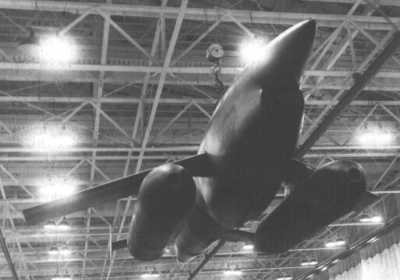 |
| Photo: via Jane's |
| AQM-34G |
The Model 147S was an improved low-altitude day-photo variant, and was built in several subvariants, the initial one being the 147SA. All 147Sx models had the short wings of the original BQM-34A, but the longer fuselage and higher-rated engine of the 147G/J. The 147SB was a further improved 147SA, and the AQM-34K (147SRE) was a night reconnaissance version of the 147SB. The 147SK was a Navy variant modified for zero-length ship launch, and was used operationally from USS Ranger (CVA-61).
 |
| Photo: Phil Callihan |
| AQM-34L |
The AQM-34L (Model 147SC) was the definitive low-altitude photo-reconnaissance variant, and by far the most numerous with several hundred built under USAF "Compass Bin" and "Buffalo Hunter" programs. Some AQM-34Ls were equipped with real-time TV camera/transmitter systems, and these were sometimes called AQM-34L/TV. The 147SC was a very successful aircraft with a mission survivability rate of 87.2%, and the AQM-34L named "Tom Cat" completed 68 successful missions. The AQM-34M (Model 147SD) was an AQM-34L modified with a real-time datalink. Some AQM-34Ms were upgraded with a LORAN (Long Range Navigation) system and designated AQM-34M(L). The AQM-34L/M could fly its missions at altitudes as low as 60-150 m (200-500 ft).
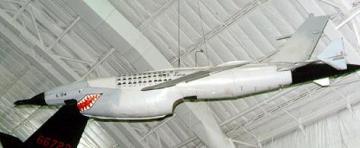 |
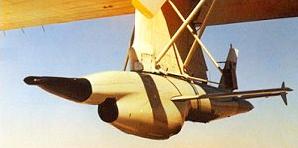 | |
| Photo: U.S. Air Force Museum | Photo: USAF | |
| AQM-34L | AQM-34M |
The AQM-34P (Model 147T) was a high-altitude reconnaissance version based on AQM-34N (147H), equipped with a significantly more powerful Teledyne CAE (formerly Continental) J100-CA-100 turbojet engine, but only relatively few high-altitude missions were flown in the 1969/70 time frame. However, in April 1969, an EC-121 Constellation SIGINT (Signal Intelligence) aircraft was shot down while monitoring enemy radio transmissions and SAM frequencies along the North Vietnamese coast. This prompted the USAF to develop a SIGINT derivative of the AQM-34P to transfer this dangerous operation to the RPVs. The result was the AQM-34Q (147TE), built under the USAF's "Combat Dawn" program. It sported numerous bulbs and aerials on its fuselage and flying surfaces. The last AQM-34Qs were fitted with underwing droptanks for longer range, and these tanks were standard on the ultimate "Combat Dawn" version, the AQM-34R (147TF). Otherwise, the AQM-34R was very similar to the -34Q, but had slightly improved SIGINT equipment.
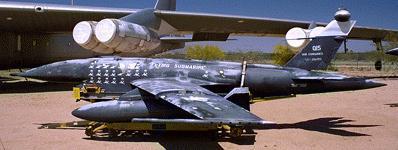 |
| Photo: Pima Air & Space Museum |
| AQM-34Q |
 |
| Photo: via Jane's |
| AQM-34R |
The following table gives an overview of the numerous Model 147 RPV variants used during the Vietnam conflict, showing Ryan model number, USAF designation, operational time frame, and number built (if known). In total, about 1000 Model 147 vehicles of all versions were built by Teledyne Ryan Aeronautical.
| Teledyne Ryan model | USAF designation | Operational use | Number built or converted |
|---|---|---|---|
| 147A | - | 4/62 - 8/62 | 4 |
| 147B | - | 8/64 - 12/65 | 37 |
| 147C | - | 10/65 | 7 |
| 147D | - | 8/65 | 3 |
| 147E | - | 10/65 - 2/66 | 3 |
| 147F | - | 7/66 | 1 |
| 147G | - | 10/65 - 8/67 | 56 |
| 147H | AQM-34N | 3/67 - 7/71 | ? |
| 147J | - | 3/66 - 11/67 | 39 |
| 147N | - | 3/66 - 6/66 | 10 |
| 147NA/NC | AQM-34G | 8/68 - 9/71 | 67 |
| 147NC | AQM-34H | 7/72 - 12/72 | ? |
| 147NC(M1) | AQM-34J | ? | 52 |
| 147NP | - | 6/67 - 9/67 | 8 |
| 147NQ | - | 5/68 - 12/68 | 10 |
| 147NRE | - | 5/67 - 9/67 | 4 |
| 147NX | - | 11/66 - 6/67 | 10 |
| 147SA | - | 12/67 - 5/68 | 40 |
| 147SB | - | 3/68 - 1/69 | 40 |
| 147SC | AQM-34L | 1/69 - 6/73 | 400+ |
| 147SD | AQM-34M | 6/74 - 4/75 | 87 |
| 147SK | - | 11/69 - 6/70 | 10 |
| 147SRE | AQM-34K | 11/68 - 10/69 | 20 |
| 147T | AQM-34P | 4/69 - 9/70 | ? |
| 147TE | AQM-34Q | 2/70 - 6/73 | 19 |
| 147TF | AQM-34R | 2/73 - 6/75 | 20 |
In 1972, six AQM-34Ls were modified as YAQM-34U to improve avionics reliablity and low-level navigational accuracy. Five of these were later converted to BGM-34C (q.v.).
In 1967, the Air Force initiated the "Combat Angel" program to modify Model 147NAs for pre-strike ECM missions, because too many manned ECM aircraft were lost over North Vietnam. However, with the bombing halt in November 1968, the pre-strike ECM capability was no longer needed, and no modified 147NA drones were used operationally in that role. "Combat Angel" was revived in 1974, however, when Teledyne Ryan was awarded a contract to modify surviving AQM-34H/Js to a standardized ECM version designated AQM-34V (TRA Model 255). The AQM-34V was first flight tested in March 1976. It was equipped with active jamming equipment and AN/ALE-2 and -38 chaff dispenser pods. About 60 AQM-34V were built, including 16 new-built drones, and were tested through 1978.
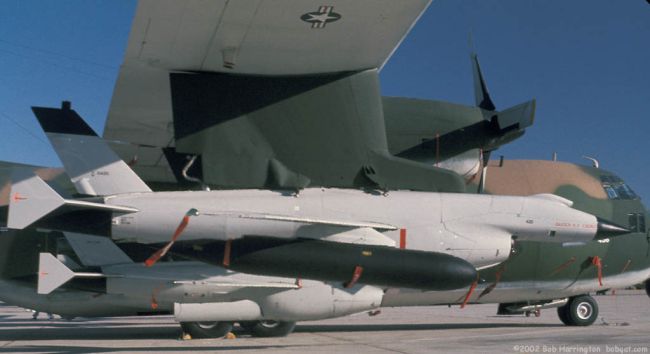 |
| Photo: Bob Harrington, Bobqat.com |
| AQM-34V |
Almost immediately after the end of the Vietnam War, the surviving AQM-34 RPVs were deactivated and put in storage. By 1977, only the AQM-34V test vehicles were still flying, and these were retired in 1979. In 1987/88, more than 50 AQM-34L/M in storage were briefly reactivated for flights to evaluate the effectiveness of several air defense and surveillance radars.
Specifications
Note: Data given by several sources show slight variations. Figures given below may therefore be inaccurate!
Data for AQM-34G/H/L/M/N/P/Q/R:
| AQM-34G/H | AQM-34L/M | AQM-34N | AQM-34P/Q/R (-34R with tanks) | |
|---|---|---|---|---|
| Length | 7.9 m (26 ft) | 8.8 m (29 ft) | 9.1 m (30 ft) | |
| Wingspan | 4.6 m (15 ft) | 3.9 m (13 ft) | 9.8 m (32 ft) | |
| Weight | -34G: 1670 kg (3680 lb) -34H: 1700 kg (3750 lb) |
-34L: 1390 kg (3065 lb) -34M: 1410 kg (3115 lb) |
1735 kg (3830 lb) | -34P: 1720 kg (3790 lb) -34Q: 1750 kg (3870 lb) -34R: 2810 kg (6200 lb) |
| Speed | ? | 1040 km/h (645 mph) | 675 km/h (420 mph) | ? |
| Ceiling | ? | 15000 m (50000 ft) | 21000 m (70000 ft) | 23000 m (75000 ft) |
| Range | ? | 1200 km (750 miles) | 3860+ km (2400+ miles) | -34P/Q: 3200+ km (2000+ miles) -34R: 5100+ km (3200+ miles) |
| Propulsion | Continental J69-T-29; 7.6 kN (1700 lb) | Continental J69-T-41A; 8.5 kN (1920 lb) | Teledyne CAE J100-CA-100; 12.4 kN (2800 lb) | |
Attack and Multimission RPVs: BGM-34A/B/C
In the late 1960s, the Navy studied the possibility to convert the BQM-34A Firebee target drone to a remote-controlled anti-ship missile. In several test flights, BQM-34As equipped with a TV system in the nose, were successfully flown by remote "pilots" watching the TV image. Precision low-level flight above the sea was made possible by the Ryan-developed RALACS (Radar Altimeter Low Altitude Control System). In September 1971, successful tests of Model 248 missiles (called "BQM/SSM") against ship targets showed the validity of the basic concept, but the project was terminated due to lack of funding.
In the same year, the USAF showed interest in a development of the Firebee I to be used for enemy air-defense suppression, because of the high loss rate in these missions. In March 1971, Teledyne Ryan received a contract to convert four Model 147S drones to BGM-34A (Model 234) configuration. Like the Navy's BQM/SSM, the BGM-34A was piloted by an operator watching a TV image transmitted from the drone's nose. In tests during 1971/72, the BGM-34As successfully launched AGM-65 Maverick air-to-surface missiles and electro-optically guided glide bombs against simulated SAM sites. Interestingly, almost 30 years later a firing of an AGM-114 Hellfire missile by an MQ-1L Predator UAV was much hyped as a breakthrough in armed UAV technology.
Following the successful BGM-34A tests, Teledyne Ryan developed the BGM-34B (Model 234A) operational strike RPV. This featured the higher-rated J69-T-41A engine, a modified tail, larger control surfaces, and improved operational capabilities. Eight BGM-34Bs were built, and tested in 1973/74. The tests included the modification of some of the drones with a new nose containing a LLLTV (Low Light Level Television) camera and a laser designator, to act as a "pathfinder" for weapon-carrying RPVs.
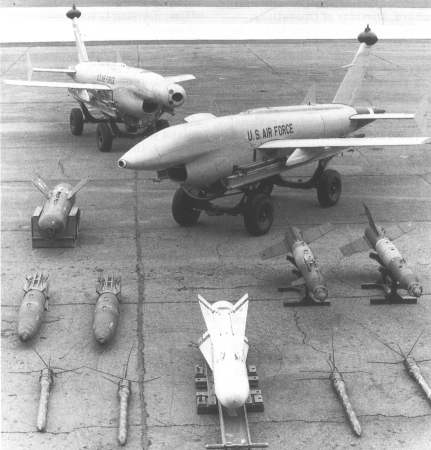 |
| Photo: Bud Wolford |
| BGM-34B |
In November 1974, the USAF had three different versions of Firebee combat RPVs in various development states: the AQM-34M reconnaissance drone, the AQM-34V ECM drone, and the BGM-34B strike RPV. It was decided to develop a single multi-mission RPV variant, designated BGM-34C (Teledyne Ryan Model 259), combing the capabilities of the three versions. Five YAQM-34Us were converted to BGM-34Cs, and these were flight-tested between September 1976 and April 1978. There were three exchangable nose sections for the BGM-34C, optimized for the reconnaissance, ECM, and strike roles. Although the tests were considered successful, no funds were approved for follow-on orders for production vehicles. This was at least in part caused by the general view of some Air Force officials, who saw the RPVs as a "competition" to the conventional manned aircraft.
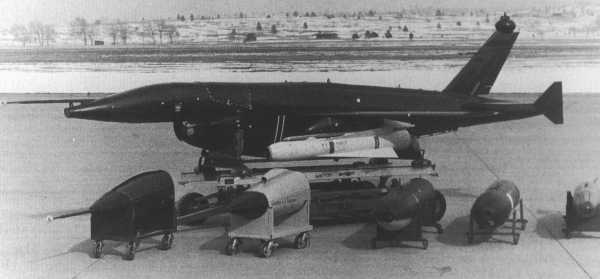 |
| Photo: USAF |
| BGM-34C |
Specifications
Note: Data given by several sources show slight variations. Figures given below may therefore be inaccurate!
Data for BGM-34C:
| Length | 8.69 m (28 ft 6.2 in) |
| Wingspan | 4.42 m (14 ft 6 in) |
| Weight | 2270 kg (5000 lb) |
| Speed | 760 km/h (472 mph) |
| Ceiling | 15000+ m (50000+ ft) |
| Range | 1400 km (875 miles) |
| Propulsion | Continental J69-T-41A; 8.5 kN (1920 lb) |
Main Sources
[1] William Wagner, William P. Sloan: "Fireflies and other UAVs", Midland Publishing, 1992
[2] Kenneth Munson: "World Unmanned Aircraft", Jane's, 1988
[3] R.T. Pretty, D.H.R. Archer (eds.): "Jane's Weapon Systems 1972-73", Jane's, 1973
[4] Bernard Blake (ed.): "Jane's Weapon Systems 1987-88", Jane's, 1988
[5] Frederick I. Ordway III, Ronald C. Wakeford: "International Missile and Spacecraft Guide", McGraw-Hill, 1960
[6] Norman J. Bowman: "The Handbook of Rockets and Guided Missiles", Perastadion Press, 1963
[7] Greg Goebel: Unmanned Aerial Vehicles Website
Back to Current Designations Of U.S. Unmanned Military Aerospace Vehicles
Back to Directory of U.S. Military Rockets and Missiles
Last Updated: 26 May 2003